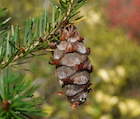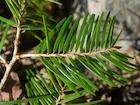Pseudotsuga japonica
(Shirasawa) Beissner 1896
Common names
トガサワラ (Toga-sawara) [Japanese] (Iwatsuki et al. 1995); Japanese Douglas Fir (Dallimore et al. 1967).
Taxonomic notes
Syn: Tsuga japonica Shirasawa 1895 (Farjon 1998), Pseudotsuga salvandori Flous 1937. The collector was Homi Shirasawa, who found the tree in July 1893 at about 600 m elevation between Owashi in Kii Province and Yoshino in Yamato Province, in a stand of hardwoods. He thought the tree a hemlock, but Beissner (1896) immediately recognized Pseudotsuga from Shirasawa's illustration, and gave the plant its current name (Hermann 1982). See the discussion in Pseudotsuga regarding the molecular systematics of this species; it shares a clade with P. sinensis. Within P. japonica, genetic studies indicate that the remaining populations are relatively isolated, with little gene flow between populations, and are at very high risk of losing substantial genetic diversity if populations continue to decline (Tamaki et al. 2018).
Description
Monoecious trees to 30 m tall and 150 cm dbh, the trunk clear of branches for about two-thirds the height of the tree. Bark dark brown, longitudinally fissured, more or less separating into plates, becoming greyish on very old trees. Twigs pale yellowish brown, glabrous, with longitudinal grooves; second year's branches grayish, with numerous more or less elevated pulvini. Winter buds conspicuous, spindle-shaped as in other species, with shiny brown, non-resinous scales. Leaves spirally arranged, linear, straight or slightly curved, 15-25 mm long, 1.5 mm wide, apex notched, upper surface grooved from base to apex, shiny green on upper surface, two stomatal bands on lower surface, 2 resin canals near sides. Flowers in April. Pollen cones axillary on previous year's shoots, cylindrical, brownish yellow, with numerous stamens. Seed cones the smallest in the genus, terminal on short branchlets, ovoid or oblong-ovoid, 4-5 cm long, 2-2.5 cm across, brown with glaucous patches when young, chocolate-brown at maturity; with 15-20 thick woody ovuliferous scales, margin minutely toothed or entire, each scale covered by a bract scale ca. 20 mm long and 4-5 mm wide with the three-lobed terminal portion strongly reflexed over the scale below, the central awn-like lobe narrower and longer than the short, blunt, lateral lobes. Cones ripen in October. Seeds shiny dark brown above, pale mottled brown beneath, triangular-obovate, 6-9 mm long, 5 mm wide; wings dark brown, broad, 10-13 mm long, 6 mm wide. It is most easily distinguished from other species in the genus by its hairless shoots and small cones" (Dallimore et al. 1967, Iwatsuki et al. 1995).
Distribution and Ecology
Japan: Honshu (Kii Peninsula) and Shikoku (Kochi Prefecture) in temperate forests at 500-1100 m elevation (Iwatsuki et al. 1995). It is rare and scattered in sheltered valleys and steep ravines, growing on silicate (volcanic) substrates. The climate is warm temperate with annual precipitation between 1,000 and 2,000 mm, distributed throughout the year. P. japonica is a constituent of mixed conifer-broad-leaved forests, usually with Tsuga sieboldii as the dominant species; other conifers may include Abies firma, Chamaecyparis obtusa, Torreya nucifera and Cryptomeria japonica. Associated angiosperms include, e.g., Quercus salicina, Q. sessilifolia, Cleyera japonica, and Illicium religiosum, and the shrubs Eurya japonica, Pieris japonica, Rhododendron serpyllifolium, and Thea japonica (Katsuki et al. 2013).
Pseudotsuga of Asia; P. japonica in green. Distribution data from GBIF, 2021.02.22.
This is currently a rare species, found only in small and scattered populations amounting to no more than 2,500 mature trees, with no population of more than 250 trees. The population trend is declining and has been for some time, largely due to habitat loss driven by plantation forestry and other forms of development. There is also some small-scale harvest (Katsuki et al. 2013).
Remarkable Specimens
Ethnobotany
P. japonica has seen some use as a timber tree, with the wood used for construction of traditional buildings and gateways and for furniture. In Japan it has been planted in some parks and traditional gardens, but outside Japan it is a rare tree, seldom seen except in major arboreta. This species was collected by Ernest H. Wilson in 1914 and introduced via the Arnold Arboretum of Harvard University to the USA. In Europe it seems to have arrived a few years earlier, perhaps a little after 1900 in Germany. It grows slowly in cultivation and seems to remain a small tree with a limited life span (Katsuki et al. 2013).
Observations
Remarks
The epithet refers to Japan.
Citations
Beissner. 1896. Mitt. Deutsch. Dendr. Ges. 5: 62.
Hermann, R. K. 1982. The genus Pseudotsuga: historical records and nomenclature. Special Publication 2a, Forest Research Laboratory, Oregon State University, Corvallis. 34pp.
Shirasawa. 1895. Bot. Mag. Tokyo 9: 86, t. 3.
Tamaki, S., K. Isoda, M. Takahashi, H. Yamada, and Y. Yamashita. 2018. Genetic structure and diversity in relation to the recently reduced population size of the rare conifer, Pseudotsuga japonica, endemic to Japan. Conservation Genetics 19:1243–1255.
See also
The species account at Threatened Conifers of the World.



